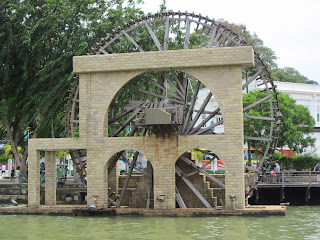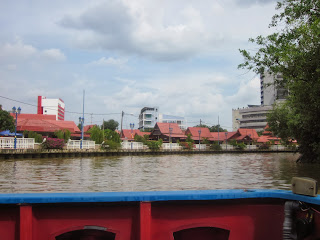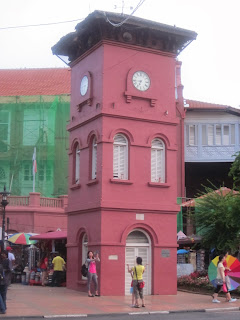 |
| Jalan Hang Jebat and an old bike (CNB 2013) |
Jalan Hang Jebat aka Jonker Walk (previously Jonker Street) is in the heart of Melaka's China town. Its fame lies in the many antique and curio shops on both sides of the street. By day it is a lively enough place, but come Friday, Saturday and Sunday evenings, the street turns into a huge and even more lively '
pasar malam' or night market. Here you jostle along with other tourists, both local and foreign, looking for antiques or knick knacks to
waste spend your money on.
 |
| One of the many antique shops in Jonker Street (CNB 2013) |
 |
| Another antique shop (CNB 2013) |
At this juncture of my pretty ordinary life, I am no longer collecting anything material (I hope), least of all antiques! So its more about looking for 'eats'.
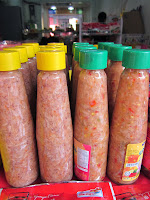 |
| Cincaluk (CNB 2013) |
Just as well, Jalan Hang Jebat is also a 'food street'. You find many little cafes and restaurants, including some famous ones like the Geographer Cafe, Famosa chicken rice ball restaurant (the halal outlet is in Tesco Hypermart, Peringgit), Jonker 88 (which I dub 'Mao's Cafe', not for their well-known dessert of '
mao lagi' durian cendol, but for the many interesting pictures of Mao Tse Tung adorning a wall), etc.
We bought a bottle of cincaluk (Melaka's most iconic food appetiser made from
udang geragau or krill) from a shop here. The very friendly shop-lady Teh, originally from Negri Sembilan is married to a local Baba. (Does this make her a Nyonya?) Anyway she speaks in good Malay, as all Baba Nyonyas do.
 |
| 'Mao's Cafe' at 88 Jonker Street (CNB 2013) |
 |
The 75 year old Royal Press where letterpress printing still
thrives (CNB 2013) |
 |
| Jonker Walk in the evening (CNB 2013) |
We observed that Jalan Hang Jebat now has some 'quirky' landmarks like a Mamee Museum (complete with its Blue Monster) and a Taman Warisan Dunia (with the statue of our very own Mr. Melaka/Malaysia/Asia/ World). Though definitely not in this quirky category, a revisit to the mausoleum of Hang Kasturi seems a must for us. (Maybe what is quirky here is the fact that the English translation of the signage for this mausoleum is atrocious. The Thomb's (sic) of Hang Kasturi? The rest of it will make you cringe even more ... another case of bad machine translation?)
 |
| At Makam Hang Kasturi (CNB 2013) |
Just off Jalan Hang Jebat/Jonker Street are some interesting shops on Jalan Hang Kasturi. Among them, about the only Malay eatery to be found, 'Aku dan Dia'. Here they serve the best
kway teow goreng and other dishes. You can finish your meal with home-made
buah melaka or
ondeh-ondeh, made before your very eyes.
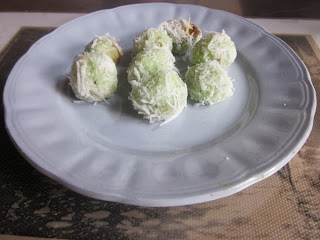 |
| Simply delicious, melt in your mouth buah melaka (CNB 2013) |
Another interesting shop in Jalan Hang Kasturi is the 'Red Handicrafts'. Its beautiful shop front never fails to prompt us to pose for pictures there when we pass by.
 |
| Red Handicrafts, off Jonker Street (CNB 2013) |
Melaka 2-5 November 2013
















